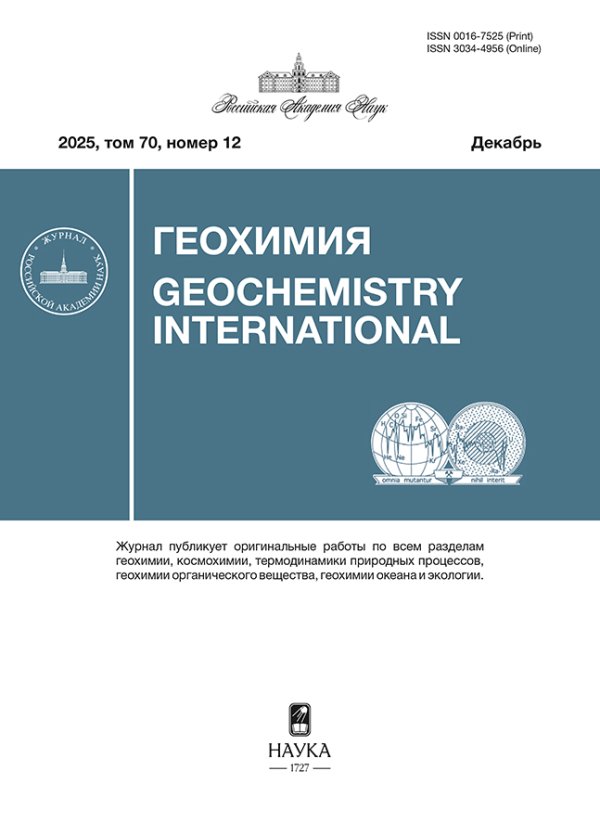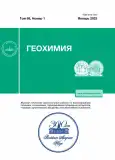Vol 68, No 1 (2023)
Articles
Trace Elements in Olivine of Volcanic Rocks: Application to the Study of Magmatic Systems
Abstract
A quantitative local analytical method with the application of inductively coupled plasma mass spectrometry with laser ablation (LA-ICP-MS) was tested at Vernadsky Institute for the determination of contents of trace elements (Cu, Zn, Co, Ni, Mn, Cr, Sc, V, Ca, Ti, Al, Y, and REE) in olivine. Olivine phenocrysts from volcanic rocks of various geological settings have been studied: island-arc basalts, mid-ocean ridge (MOR) basalts, and high-alkaline continental volcanic rocks. The contents of some elements (Ni, Co, Mn, Cr, Sc, and Zn) systematically vary during the evolution of the composition of olivine, and the concentration fields of these elements in olivine from different settings overlap one another. At the same time, the contents of some other elements (Ca, Al, Ti, V, and Cu) fundamentally differ in olivine from different geological settings. Copper content in olivine from oceanic tholeiites and highly alkaline continental volcanics is 1–3 ppm, which is systematically lower than copper content in olivine from island-arc basalts (3–9 ppm). The concentrations of vanadium in olivine in MOR basalts are higher than in island-arc and alkaline continental ones, which may be due to relatively more reduced crystallization conditions as more favorable for the incorporation of V3+ into the olivine structure. Variations in the distribution coefficients of trace elements between olivine and silicate melt (DOl/Melement) were determined for volcanic rocks from Kamchatka, the Bouvet Triple Junction, and Gaussberg volcano. It has been demonstrated that the unusually high values DOl/MNi of DOl/MNi = 50–150 previously identified for the lamproites of Gaussberg volcano indicate a mismatch between the composition of the quenched glass and the composition of the equilibrium melt for olivine phenocrysts. When using the bulk compositions of Gaussberg rocks, values of DOl/MNi = 11–21 were obtained, which correspond to experimental estimates for high-potassium rocks. The redox crystallization conditions of the studied rocks were estimated using several oxybarometers based on the distribution of vanadium between coexisting olivine and melt. These values were: ΔQFM= +0.6 to +1.5 for oceanic tholeiites of the Bouvet Triple Junction area, South Atlantic, and ΔQFM = +1.5 to +2.4 for Mutnovsky volcano, Kamchatka. Estimates of the redox crystallization conditions of the highly alkaline rocks of Gaussberg volcano significantly vary depending on which model is chosen: ΔQFM= +0.2 to +4.8, which may be due to the strong effect of K2O content in the melt involved in one of the models. The newly acquired analytical data confirmed the possibility of using contents of trace elements in olivine to characterize igneous systems from different geological settings and highlighted the need for additional experimental studies on the distribution of these elements between olivine and melt, especially in highly alkaline systems.
 3-26
3-26


Effect of Sulfide Sulfur on the Crystallization of Low-Alkali Magmas: Prolegomena
Abstract
The effect of sulfide sulfur on the crystallization of ultramafic–mafic–intermediate magmatic systems is considered in order to assess its scale and direction during the crystallization of rock-forming phases. The study carried out a theoretical analysis of the effect of sulfur on the activity of the components of the silicate melt according to the Korzhinskii’s principle of acid–base interaction. To test the theoretical constructions, published experimental data analyzed to select data allowing a direct comparison of sulfur-saturated and sulfur-free runs. Despite the very limited number of such experiments, they all fit well with theoretically predicted trends. It has been established that the addition of sulfur to the system moderately reduces the liquidus temperature of rock-forming minerals within 20–30°C, and significantly affects their composition. In particular, chrome spinel is enriched in chromium by 10–12 mol % and complementary depleted in aluminum. The composition of plagioclase is enriched in the anorthite component by 3 mol % in dacites and 8 mol % in andesites; this effect was not established in basalts, but its strengthening can be expected. Olivine and orthopyroxene demonstrate an insignificant increase in magnesian content, but the field of their coexistence is significantly reduced in favor of orthopyroxene, which should inevitably lead to a change in their cotectic and peritectic proportions. Natural observations that can be interpreted as the result of the sulfur effect are taken from publications. The results obtained lead to the conclusion that sulfur significantly affects the crystallization of silicate magmas. It follows that the petrological dependences calibrated for sulfur-free experiments should be applied with caution to the interpretation of sulfur-bearing systems.
 27-47
27-47


Sr, Nd, Pb, and Os Isotope Systematics and Derivation of Mesozoic Plume-Related Basalts of Antarctica: Karoo-Maud and Kerguelen Plume Realm
Abstract
The study of Re–Os isotopic systematics of the Mesozoic magmas in East Antarctica and its comparison with Sr–Nd–Pb–Os published data allowed us to reveal the main features of Antarctic magmatism associated with the activity of the Karoo–Maud (Dronning Maud Land (DML), Karoo and Ferrar provinces) and the Kerguelen (Lambert rift area) plumes. It is shown that a melt source of the 180-Ma Karoo–Maud plume could be enriched lithospheric mantle. Variations of the 187Os/188Os ratio in the range of 0.1242–0.1426 characterize almost all types of melts in the Karoo and DML provinces, including both high- and low-Ti magmas as well as high-Mg ferropicrites produced by melting of mantle pyroxenite. This observation is consistent with previous assumption that magmas derived from pyroxenite mantle at the initial stage of plume impact represented melts of deep lithospheric fragments of ancient Gondwana paleocontinent that were entrapped by plume. Thereby, mantle heterogeneity recorded in the Nd–Pb–Sr isotopic compositions of the basalts is not expressed in the systematic variations of Re–Os isotope system. The magmatic source of the basalts of the Ferrar province differs from the source of Mesozoic magmatism in the Karoo and DML provinces by great variations in the 187Os/188Os ratio: from 0.1 to 0.31, and by the lower osmium contents, with limited variations of other isotopic systems, indicating an admixture of enriched EM-II source. This is consistent with inferred subduction reworking of the mantle of the western Antarctic margin (Sushchevskaya et al., 2022). Ultramafic picritic magmas from the Lambert Glacier area are characterized by a radiogenic osmium isotopic composition: 187Os/188Os 0.1582–0.2388. Source of these magmas could be ancient depleted mantle, which later experienced mantle metasomatism due to the multiple interactions with fluid-saturated melts. Picritic melts of the paleorift zone of the Lambert Glacier are close to a magma source of the Karoo and DML provinces in terms of Sr-Nd isotopic composition, but differ in more radiogenic lead.
 48-68
48-68


Late Mesozoic Adakite Granites in the Northern Framing of the Eastern Flank of the Mongol–Okhotsk Orogenic Belt
Abstract
The examination of original and available petrochemical, geochemical, and isotope (Sm-Nd, Rb-Sr) data showed that subalkaline granitoids in the northern framing of the eastern flank of the Mongol–Okhotsk orogenic belt belong to the adakite series. The granitoids are characterized by high Sr/Y, Sr, Al2O3, and LREE, extremely low HREE concentrations, and the absence of negative Eu anomalies. The results obtained and the analysis of the geodynamic setting of their formation made it possible to assume that the granitoids were formed at a depth of more than 45 km through melting of garnet-bearing (20–50% garnet) rocks, which are likely represented by lower crustal Precambrian complexes widespread in the southern framing of the Siberian craton. The source of parental melts involved both mantle and crustal matter. This likely occurred in a subduction setting through melting of frontal or lateral parts of oceanic slab in subduction “windows”. The Late Jurassic–Early Cretaceous Chubachin adakite complex (149–138 Ma) was distinguished. Its formation preceded the initiation of suprasubduction differentiated calc-alkaline magmatism (140–122 Ma) in the northern framing of the eastern flank of the Mongol–Okhotsk orogenic belt.
 69-82
69-82


Thermodynamic Properties of Pectolite
Abstract
Pectolite H1.00Na0.96Ca2.00Mn2+0.02Si3.00O9 from nepheline−feldspathic veins in the Kovdor massif, Kola Peninsula, Russia, was studied by X-ray diffraction (XRD), IR and Raman spectrometry, microprobe analysis (EPMA), and thermal analysis. The enthalpy of formation of pectolite HNaCa2Si3O9.from elements ∆fH° (298.15 K) = –4651.0 ± 4.3 kJ/mol was determined by melt solution calorimetry on a Setaram Tian–Calvet (France) microcalorimeter. The enthalpy of formation of serandite HNaMn2Si3O9, the manganese end member of the pectolite–serandite isomorphic series, was determined to be ΔH(298.15 K) = −4052.6 ± 4.4 kJ/mol. The absolute entropies and Gibbs energies of pectolite and serandite were calculated.
 83-89
83-89


Geochemical Markers of Stagnant Zones in an Urban Heat Island
Abstract
The paper presents data acquired by a comparative study of the vertical variability in the chemical composition and ratios of aerosol subdisperse fractions in snow layers chronologically correlated with the stratigraphically significant snowfall periods. These data highlight features of the concentrating of trace elements at reactive (geochemical) barriers in the snow profile. The ratio of three geochemically close groups of elements, such as siderophile, sulfophile, and lithophile elements, were found out to vary relatively little from one snow layer to another in the growing snow cover. Trajectory analysis of the transfer of air masses to which stratigraphically significant snowfalls were related to the observation site provides no evidence that the identified geochemical phenomenon can be explained by that the winter aerosol field that was formed above an urban area with different trajectories of air masses can be somehow inherited in the snow layers of the growing snow cover and thus affect the vertical distributions of trace elements. Evidence indicates that that the ratios of assemblages of trace elements in the discrete snow layers, which remain stable with the growth of the snow mass, can be employed as geochemical markers of stagnant zones in an urban heat island, and the method of geochemical sampling of a snow cover in its discrete layers at a rare network of urban meteorological observation sites is an efficient additional tool for studying microscale atmospheric processes and recovering information on characteristics of the transfer of pollutants in a spatially limited urban area.
 90-104
90-104


Actinides Th and U in Atmospheric Particulate Matter in Yakutsk
Abstract
The distribution of Th and U was studied in the near-ground atmosphere of the city of Yakutsk. The chemical compositions of particulate matter (PM) in the summer atmosphere and in the solid and soluble phases of the snowpack were studied in 2019–2020. In the summer atmosphere, Th and U are concentrated mostly in the dust fraction of PM, together with a group of siderophile elements. The wintertime PM is characterized by a more homogeneous size of its particles. PM minerals with which concentrations of actinides correlate are amphiboles and pyroxene for Th and carbonates for U. The Th and U concentrations were found out to systematically decrease in the sequence soil–summer PM (dust)–winter PM (snow), at the dominance of Th, but the aqueous phase of the snow contains U concentrations one order of magnitude higher than those of Th. The bulk (close to 90%) of actinides is deposited during the warm season. The total amount of actinides falling out in Yakutsk is 63 mg/(m2 year), with two-thirds of this amount being Th. This value may locally increase to 200 mg/(m2 year) and more in areas of contrasting anomalies, with the predominance of Th. The main sources of actinides entering the near-ground atmosphere of Yakutsk are dusting from the soil surface and emissions from vehicles, with lesser amounts coming from energy-producing and construction-industry facilities.
 105-112
105-112












